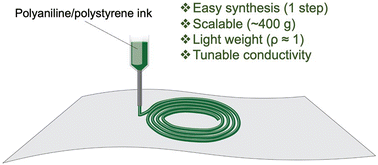Additive manufacturing of polyaniline blends for lightweight structures with tunable conductivity†
Abstract
Printable feedstocks that can produce lightweight, robust, and ductile structures with tunable and switchable conductivity are of considerable interest for numerous application spaces. Combining the specific properties of commodity thermoplastics with the unique electrical and redox properties of conducting polymers (CPs) presents new opportunities for the field of printed (bio)electronics. Here, we report on the direct ink write (DIW) printing of ink formulations based on polyaniline-dinonylnaphthalene sulfonic acid (PANI-DNNSA), which has been synthesized in bulk quantities (∼400 g). DNNSA imparts solubility to PANI up to 50 mg mL−1, which allows the use of various additives to tune the rheological behavior of the inks without significantly compromising the electrical properties of the printed structures, which reach conductivities in the range of <10−7–100 S cm−1 as a function of ink formulation and post treatment used. Fumed silica (FS) and ultra-high molecular weight polystyrene (UHMW-PS) additives are leveraged to endow printability and shape retention to inks, as well as to compare the use of traditional rheological modifiers with commodity thermoplastics on CP feedstocks for tailored DIW printing. We show that the incorporation of UHMW-PS into these ink formulations is critical for obtaining high crack resistance in printed structures. This work serves as a guide for future ink designs of CPs with commodity thermoplastics and their subsequent DIW printing to yield conductive architectures and devices for various applications.

- This article is part of the themed collection: 2023 Journal of Materials Chemistry C HOT Papers


 Please wait while we load your content...
Please wait while we load your content...
